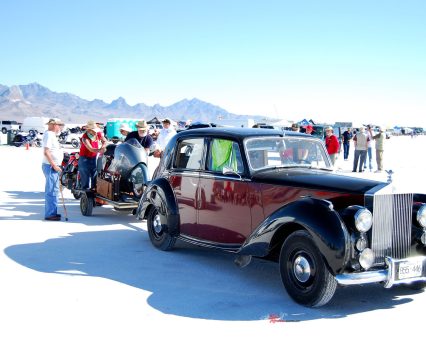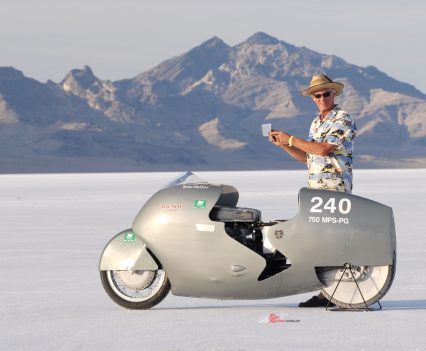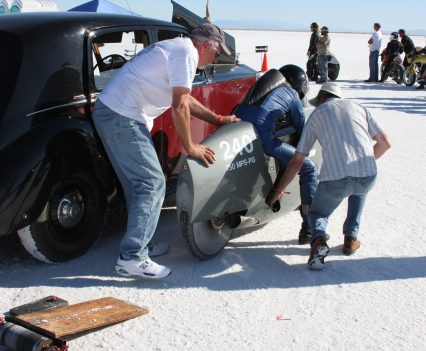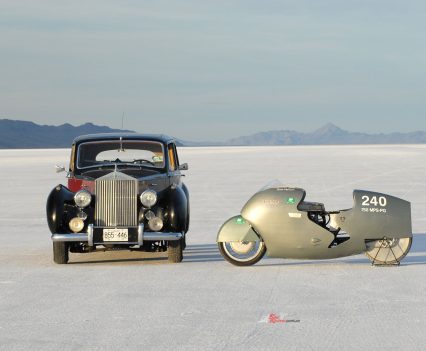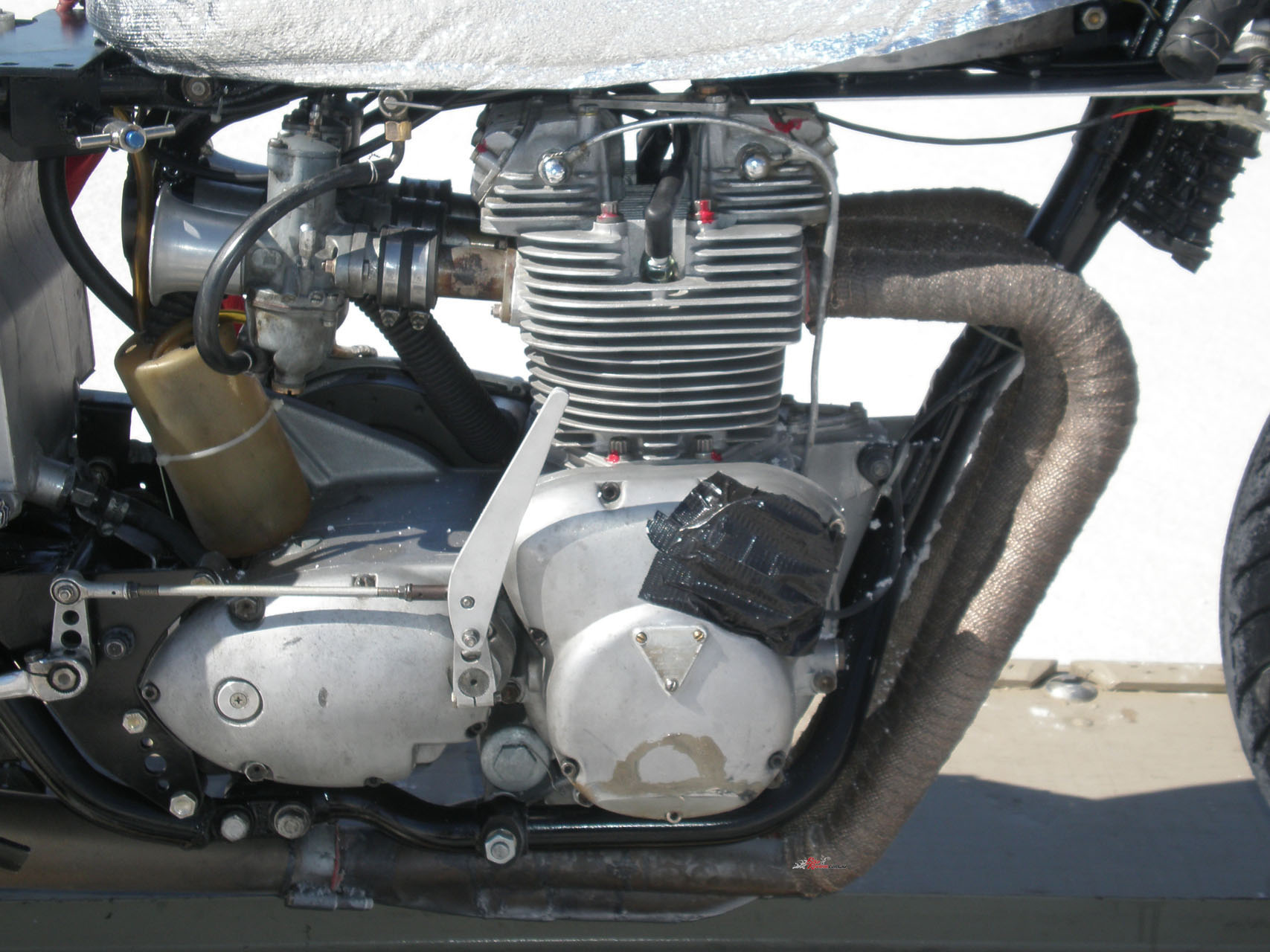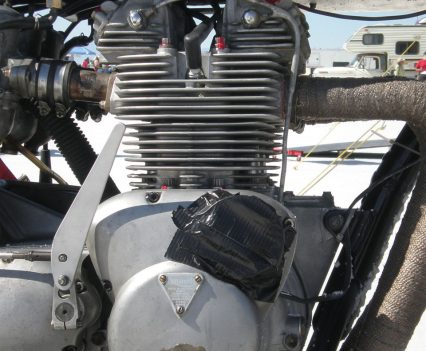Sir Al delves into the development and achievements of Tom Mellor’s stunning Bonneville Triumph Trident Streamliner, the World’s Fastest Trident... Photography: Steve Bohn
It’s not every day you see a Rolls-Royce Silver Dawn limousine, for one thing they were only manufactured for a few years, during the height of Britain’s postwar austerity era from 1948 to 1955. As Royces go, it’s a rare bird, and you wouldn’t expect to see a red-and-black one…

The Silver Dawn was never sold in Britain – only the less costly Bentley R-Type, essentially the same car with less glitz, but an identical six cylinder 4257cc engine.
Bonneville-bound with Canadian plates, sailing like a stately ocean liner along the high desert Interstate highway during the three-day voyage from British Columbia to western Utah – still less towing a trailer bearing such improbable cargo as a strangely-shaped motorcycle strapped beneath a canvas cover.
But it was this unlikely rig which in 2008 conveyed Tom Mellor and wife Diane with their 1969 Triumph Trident T150 to the Bonneville Salt Flats, where the Canadian rider set four new land speed records with the bike that was the toast of the Salt on the 40th anniversary of the Trident’s first appearance in the summer of 1968.

“The 750 Mellor Triumph Trident stood out at Bonneville 2008 as the loveliest-looking such creation, with performance to live up to its sleek, streamlined appearance”…
Each September when Salt conditions permit, the annual Bonneville Speed Trials feature an amazing array of eclectic engineering, often displayed via motorcycles which are the spare-time product of a dedicated enthusiast’s energetic efforts and enquiring mind. In a paddock improbably dominated by Harley-Davidson, Triumph, Vincent and Suzuki-powered devices devoted to worshipping the great god of Speed (Honda and Kawasaki are bit players, Yamaha missing in action, and Ducati merely a Latin curiosity), the 750 Mellor Trident stood out at Bonneville 2008 as the loveliest-looking such creation, with performance to live up to its sleek, streamlined appearance.
Tom Mellor was clocked at 180.317 mph over the flying mile, and 180.497 mph for the flying kilometre on the Triumph…
Running in the 750MPS-PG class (750cc Modified Production pushrod, pump fuel (‘gas’), partially streamlined – so the front wheel and rider must both be visible), Tom Mellor was clocked at 180.317 mph over the flying mile, and 180.497 mph for the flying kilometre on the Triumph, fitted with wind-cheating bodywork he’d created himself.
Next day, having removed the main fairing to qualify for the 750MP-PG class (so, 750cc Modified Production pushrod, pump fuel, with no bodywork, but with the rear fairing left on as it counts as the seat!), Tom and his Triumph set two more two-way records of 159.916 mph for the kilo, and 159.905 mph for the mile – proof positive of how effective that home-made streamlining had been. Not bad for a 40-year old 750 streetbike Tom had prepared himself with the help of two British-born mates aka The Two Bobs (sounds like a ‘60s comedy duo!) in a workshop beside his Vancouver home.

Tom and his Triumph Trident set two more two-way records of 159.916 mph for the kilo, and 159.905 mph for the mile…
The nature of his former trade gives a clue as to how Mellor’s accomplishment came about in creating the World’s Fastest Trident – well, one with pushrods, anyway. The late Jack Wilson, proprietor of Big D Cycle in Dallas, Texas and creator of the twin-cylinder Triumph-engined Texas Ceegar with which Johnny Allen broke the Land Speed Record at Bonneville back in 1956 (which in due course gave rise to the iconic Bonneville model) broke lots of records with twin-engined Triumph pushrod triples, and even set marks with single-engined bikes fitted with turbos – but even he never achieved what Tom Mellor did with his stock, unsupercharged, 750cc Trident T150.

The late Jack Wilson never achieved what Tom Mellor did with his stock, unsupercharged, 750cc Triumph Trident T150.
But back to Tom’s trade. “I was an aircraft maintenance engineer at Vancouver International Airport, working for Canadian Pacific Airlines for 23 years, then I had two more years with Air Canada after they took them over,” he revealed, with an offhand sense of pride. “But I didn’t like the way they did things, so I retired. I started working on the DC8, 727 and 737, then moved on to the 747, DC10 and 767, working mainly on the engines.
“But if you hang around aircraft long enough, you get to know what’s correct aerodynamically. So when people ask me how I made the Triumph go so fast, I tell them there are lots of modern Superbikes out there that aren’t even as streamlined as the Sopwith Camel – it’s old technology they all use, for some reason. We aimed to do a little better with this old girl….!”

“So when people ask me how I made the Triumph go so fast, I tell them there are lots of modern Superbikes out there that aren’t even as streamlined as the Sopwith Camel – it’s old technology they all use, for some reason”…
Tom Mellor’s involvement with Triumph triples began 20 years earlier when he bought his first such bike from a friend who’d just acquired a vintage Frazer-Nash car, and didn’t want his now redundant Trident motorcycle. After riding it for a while on the street, including a couple of touring vacations with Diane as pillion, Tom was tempted into going racing with it, winding up a five-time British Columbia province champion in 750 Vintage, before he started venturing further afield to race with AHRMA across the US border. “We do OK in AHRMA – I can keep up front,” said Tom modestly. “It started out life as a ’69 bike, but I don’t know what year you’d call the engine that’s in there now, because I get new original crankcases wherever I can. It’s still a 750 rather than an 850, though, because that’s what I bought, and you race what you have”.
It was thanks to AHRMA that Mellor’s first involvement with Bonneville came about in 2006, when he decided to race in the inaugural US Vintage round at the then-new Miller Motorsports Park outside Salt Lake City, just 100 miles from Bonneville. “They said that for $75 you could do a run on the Run Whatya Brung short course on the Salt, so I came on down. Well, you were only supposed to do a maximum of 130mph there, but I ran through at 148mph, and the guy wouldn’t give me my ticket because he said I went too fast.
So I had to pay a bunch of money to get out onto the long course, but then I ended up with a five-mile headwind and couldn’t go any faster. The existing record was only 129mph, so in 2007 I decided to get serious about breaking it. This was my production 750 road racer with the Slippery Sam bodywork, so we needed something more aerodynamic. My friend Shane Kanawi has six Bonneville records with a Suzuki GSX-R750, and he had a mould for the bodywork which he loaned me. I had to cut it up quite a bit to make it less wide to fit the narrower Triumph, but that’s what we ran with that year.”
The Mellor Triumph Trident first entered the record books in 2007 in the 750PG class – but not as fast as expected. “The weather was awful, so after I did 158mph one way, when I went to do my return run, there was lots of lightning and a big thunderstorm heading up, so they wouldn’t let me out on the track. You have to make the reverse run within two hours, so that meant I had to start over again next day, but now the track was all wet and slushy, so the best speed I could do was 139, with lots of wheelspin. Still got the record, though. But we couldn’t wait around for the salt to dry out, because I had to convert the bike back to road racing spec with the Slippery Sam fairing to run at Miller that weekend. Did OK, too – I finished third in 750 Production!”
“The next year I decided just to focus on Bonneville, which was unfinished business…”
Tom said he didn’t much care for the Miller track, and anyway it had taken a day and a half to convert the Triumph from speed racer to road racer to combine competing at both venues. “I had to have friends bring the road race bodywork down separately, plus my forks and suspension, so the next year I decided just to focus on Bonneville, which was unfinished business.” So to address this most effectively, Mellor bought another T150 Triumph frame and cut’n’shut the front-end, raking out the head angle out to 30 degrees, and adding an 11-inch/280mm extension to the swingarm, all for extra stability at high speed.

Mellor also made the half-gallon fuel tank himself, covered by a silver foil shroud to keep the fuel cool in the Utah sunshine.
“I also lowered the frame so that the upper rails run right down on top of the engine, which means the bar that I put across there to stiffen it up has to be unbolted to remove the engine. This brought it down another two inches, then I tightened up the aerodynamics on the bodywork by remaking the fairing and doing extra stuff like the front mudguard, which took me two days to make out of solid aluminium. Looks nice, though.” Mellor also made the half-gallon fuel tank himself, covered by a silver foil shroud to keep the fuel cool in the Utah sunshine – the 750 Trident’s pushrod triple motor delivered 60mpg at 180mph, so that half-gallon was good for five runs, including warming up and returning to the paddock.
339lb/154kg in road racing form to around 450lb/225kg at Bonneville, complete with streamlining…
Mellor had retained the original Trident forks and twin Girling shocks at the rear, had sheeted in the rear wire-spoked wheel with aluminium to reduce drag, and used a rear disc brake matched by a Yamaha TZ250 twin leading-shoe drum up front that’s had some work done on it. “I took the shoes out and put half-inch aluminium discs in there, then machined them to fit around,” Tom explained. “It’s better than having a disc brake hub on the front because only 25 per cent of the spokes are exposed, and weight isn’t an issue.” Indeed, the final step on the chassis was to add a 75-pound lump of lead just in front of the rear wheel, a common Bonneville tuning trick aimed at delivering extra traction. This bumped the weight up from 339lb/154kg in road racing form to around 450lb/225kg at Bonneville, complete with streamlining.
Before preparing the 750cc T150 three-cylinder engine for record breaking on the Salt, Mellor first sourced a close-ratio 5-speed gearbox from the leading BSA/Triumph triple competition specialists in the UK, P&M Motorcycles, which he matched to a standard chain primary drive. “I don’t mess with belts,” he declared. “I’ve seen too many people break them, I have no problem with a bit of weight there with the chain, even on a road racer, which this bike is not, now!” Tom ran a conventional racing clutch, after the lightened alloy one he built got warped – “It’s all those road racing hole shot starts, I guess!”
To prepare the Trident T150 engine for Bonneville duty, Mellor spent an entire week carefully lightening the crank by 10lb/4.5kg on a lathe, then shot-peened the result and fitted a P&M large volume oil pump. He used Carrillo rods with Omega pistons, and standard size valves carrying R&D titanium springs, operated via Johnson cams and lightweight aluminium pushrods. “You don’t want to go any bigger on valve sizes, because Triumph valves are plenty big enough,” he said.
“They’re too big, in fact, so you don’t go bigger. I milled out the cylinder-head, and got the intakes slightly more angled for extra downdraft, then I ported it myself and fitted the stock 32mm Amal carbs, which aren’t even smoothbores and especially not Mikunis, so there’s extra performance we could have right there. I was going to go to 34’s, but I didn’t have time to test them on the dyno.”
The reworked, ported cylinder-head had a high 14.3:1 compression, which meant running on 112 octane fuel (still OK for the pump gas rule, though!), and ran 10mm spark plugs moved a little closer to the centre of the piston. “I don’t run two spark plugs, ‘cos it doesn’t make any difference,” Tom stated. “I’ve got a really tight combustion chamber, which it turns out is the same design as the one the books say that Ducati used to use when they were running 500GP V-twin engines and 250/350/450 singles, all with two-valve heads.
“They called it ‘a spectacle combustion chamber’, and there’s really just the valve cut-outs in there – the rest of it is all squish area. Now the motor revs to 9,300rpm, and two weeks before leaving when I checked it, it gave 82bhp at the rear wheel at about 9,000rpm. In fact, that fastest run I did, I was doing 9,500 all the way down the long course, and we had it geared just right. The first sprocket we chose pulled 171mph at max rpm, then we dropped it two teeth and pulled 180. Dropped two more teeth, and would still only pull 180 – so we got the old girl going as fast as she’ll go.”
And sounding great doing it, too, with a mellow howl from the 3-1 Rob North exhaust, with California resident (and former BSA/Triumph factory chassis guru) Rob North himself looking on with satisfaction – he’d just happened to be visiting the Speed Trials with some friends from his home in National City, California, just north of the Mexican border, and came across the Mellor Triumph. “I really admire what Tom’s done with his bike,” said North. “It just shows what (BSA/Triumph chief engineer) Doug Hele and his guys could have done if they’d had better support from management back then.” Indeed so – but instead it took a 59-year old retired aircraft maintenance engineer from far Western Canada to do it for them, with a bike that didn’t miss a beat during its entire week on the Salt, even running flat out repeatedly over a seven-mile stretch – a fact which reflected great credit on its home tuner-cum-pilot.
But, still – if the speed of the 40-year old Triumph and its svelte streamlined looks wasn’t enough to make it the most photographed bike at Bonneville 2008, Tom and Diane Mellor’s choice of transportation clinched it. How about the Rolls Royce, Tom? “Well, I’ve had it for 28 years, and it’s been reliable transportation for us all that time. It’s an original Canadian car – a guy from Victoria B.C. bought it new, and then my Dad got it from him, and now I’m the third owner. I don’t baby it, and these cars are cheap to run if you look after them yourself – you just have to change the oil regularly. I haven’t had to do any major repairs to it yet.”
The Silver Dawn was never sold in Britain – only the less costly Bentley R-Type, essentially the same car with less glitz, but an identical six cylinder 4257cc engine with overhead inlet and side exhaust valves, was available in the UK. The Rolls-Royce was intended as an export-only model, so most were left-hand drive with a column gear-shift, and a mere 785 examples altogether were produced between 1949 and 1955, as opposed to over 7,500 Bentleys over the same time period. “We don’t use it around town, just for hauling the Triumph and stuff,” says Tom, “so on average we do maybe 5,000 miles in it each year. But we’ve used it to drive all the way down to Daytona more than once, and that’s an 8,000 miles roundtrip! The Rolls cruises at 60mph with the trailer, and gets 20mpg – it’s more economical than a van, and quite a bit more comfortable!”
So did his Bonneville success mean road racing was off the agenda for Tom Mellor in the future? “No way! That’s the best possible route to get the bugs out of your engines. If those guys with the modern Triumph Bonnevilles that were running alongside us here on the Salt [for which the Rolls-Royce often acted as starter: see photos!] had taken them road racing, they’d have found out all of their various problems right away, and sorted them.”
But was Bonneville nevertheless now the main agenda for Tom Mellor? “I love it. You can take all of your skills and put them in one package, your building skills, and your development skills, and then go out there and see if you can break the record. You go home, you spend the next year trying out all this stuff, and then come down here again, and see if it works. It’s just a great challenge to take on with the support of my wife Diane.
“We’ve been married for 29 years, and she’s a big help in getting me organised, which makes such a difference when you get so few shots at getting the record – you have to make each run count.” How’s that sit with you, Mrs. Mellor? “Oh, I don’t mind sitting around in the sunshine while he gets on with his speed stuff,” said Diane. “Just give me a nice book and I’ll be OK. He has to pay for it when we get home, mind – I like to go hiking, so that’s the payoff. A week up in the hills in Western Canada away from the workshop is Tom’s equivalent of my coming to Bonneville!” Sounds like a fair trade….
Read Alan’s other Throwback Thursday articles here…



